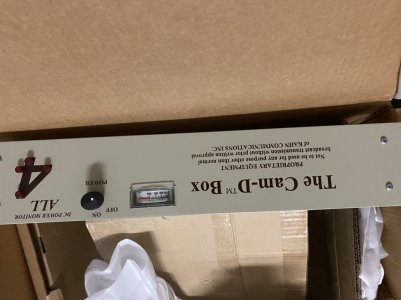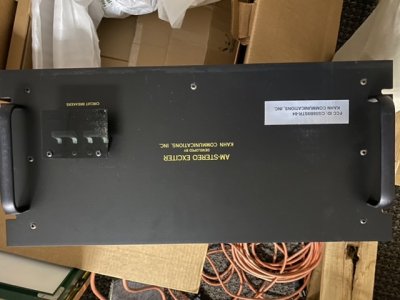I came across Leonard Kahn’s Compatible AM Digital encoder units ... anybody interested in it / has a use for it ?
-
Get involved.
We want your input!
Apply for Membership and join the conversations about everything related to broadcasting.
After we receive your registration, a moderator will review it. After your registration is approved, you will be permitted to post.
If you use a disposable or false email address, your registration will be rejected.
After your membership is approved, please take a minute to tell us a little bit about yourself.
https://www.radiodiscussions.com/forums/introduce-yourself.1088/
Thanks in advance and have fun!
RadioDiscussions Administrators
You are using an out of date browser. It may not display this or other websites correctly.
You should upgrade or use an alternative browser.
You should upgrade or use an alternative browser.
Leonard Kahn’s CAM-D
- Thread starter MHZRADIONERD
- Start date
Holy crap! Those still exist?
Last edited:
At least one does  any museums want it
any museums want it 
You might check with the Pavek Museum in Minnesota. They have an amazing collection of broadcast equipment and may have a place for it.At least one doesany museums want it

Them, or you might also think about the Museum of Communications in Seattle (STTLWADUDS0). They mostly specialise in telephones and switching equipment made by Western Electric but they also have a small collection of radio equipment and they may be interested in oddities like a CAM-D processor. CAM-D is still a part of telecommunications technology history, even if it only ended up a minor footnote.
Connections Museum Seattle | The Telecommunications History Group, Inc
Connections Museum Seattle | The Telecommunications History Group, Inc
Last edited:
Thanks! Will look into that.... otherwise any am stations want to test it out? 
Nice! Could you please also pop the cover off and get some shots of the inside? Would be interesting to see what's in there that made Leonard so paranoid and wrathful....
Note, of course, that they wouldn't be able to do that without prior written approval of KCI..... yeah, uh huh. 🤣
otherwise any am stations want to test it out?
Note, of course, that they wouldn't be able to do that without prior written approval of KCI..... yeah, uh huh. 🤣
Last edited:
The next question is whether there are any AM receivers with Kahn's stereo system that still survive. I remember listening to a Kahn demonstration tape that purported to show the lack of "platform" motion, or the swirling of audio from left to right channels, when there was co-channel interference.
Might have been a superior system, but seemed like Kahn made some bad tactical moves
Might have been a superior system, but seemed like Kahn made some bad tactical moves
Many broadcasters blame Kahn for dooming the whole AM stereo system proposal by taking legal action against the FCC to void the late 70's decision on the approved system. It delayed use of AM stereo for nearly 5 years, by which time the window on AM's possible ability to compete with music broadcasts was long closed.The next question is whether there are any AM receivers with Kahn's stereo system that still survive. I remember listening to a Kahn demonstration tape that purported to show the lack of "platform" motion, or the swirling of audio from left to right channels, when there was co-channel interference.
Might have been a superior system, but seemed like Kahn made some bad tactical moves
To the best of my knowledge, only one AM station in my area experimented with the Kahn/Hazeltine stereo system....
(Then) WKBR 1250 (Manchester, NH) played with it for about 2 months, then AFAIK passed it over; I never did learn if they eventually went with Motorola's C-QUAM.....or just scrapped the whole stereo plan......
(Then) WKBR 1250 (Manchester, NH) played with it for about 2 months, then AFAIK passed it over; I never did learn if they eventually went with Motorola's C-QUAM.....or just scrapped the whole stereo plan......
It's the same system that XETRA used experimentally in the early 70s.To the best of my knowledge, only one AM station in my area experimented with the Kahn/Hazeltine stereo system....
(Then) WKBR 1250 (Manchester, NH) played with it for about 2 months, then AFAIK passed it over; I never did learn if they eventually went with Motorola's C-QUAM.....or just scrapped the whole stereo plan......
No. You're thinking of Kahn's PowerSide. That's the device that used only part of the stereo exciter.As I recall, Cam-D is a bi-product of Kahn's AM stereo system and as long as you don't use the stereo part, does not require additional approval for use.
The Cam-D was a totally different device. Cam-D used the analog AM for low and lower mid frequencies and added a digital signal in the sidebands for the upper mid and high frequencies. It was a rather bizarre system which did nothing to reduce or eliminate the AM impulse noise. I'm not sure that anyone manufactured receivers for the system.
There are only Sonys and the Metrosound AMS400 that decoded Kahn. No licensed rcvr was ever sold. Kahn shot himself in the foot with no rcvrs covering his products. As to superior, no.. Kahn had no separation above 6/7 kHz where Cquam goes to 20khz with 30 to 35db. The platform motion issue was minimized in later chip designs and was only evident in skywave areas...plus Kahn had different freq response per channel if the antenna system was not equal in reactance +/- carrier....especially DAs...Cquam is more tolerant of this.The next question is whether there are any AM receivers with Kahn's stereo system that still survive. I remember listening to a Kahn demonstration tape that purported to show the lack of "platform" motion, or the swirling of audio from left to right channels, when there was co-channel interference.
Might have been a superior system, but seemed like Kahn made some bad tactical moves
I don't even think Kahn had rcvrs...two AMs in SETX bought into CamD ...when it was flipped on, they made a big deal about it with Beaumont mayor present throwing the switch... I called them and asked where to get a rcvr and got hung up onNo. You're thinking of Kahn's PowerSide. That's the device that used only part of the stereo exciter.
The Cam-D was a totally different device. Cam-D used the analog AM for low and lower mid frequencies and added a digital signal in the sidebands for the upper mid and high frequencies. It was a rather bizarre system which did nothing to reduce or eliminate the AM impulse noise. I'm not sure that anyone manufactured receivers for the system.
Some of the other Kahn products were when AM radios used analog tuning and did not use sharp cut off ceramic IF filters. Distinction should be made between pre and post 125 percent positive peak rule. Also note that $600 in 1965 is equivalent to approximately $5,000 in 2020. Some of these things don't seem like a big financial deal in today's dollar, but they were then.
If I may indulge- I was CE of an AM station with Audimax and Volumax, and we had home-made version of RCA Power-Max in line after the Volumax at night. This was 1 KW day/ 250 watts night on a local channel, so.... you get the drift. We ran up to 180 percent on the positives at night, depending on how grungy we wanted it to be. The entire station maintained phase, and every mic was phased for most voices, even on spots. Being a kid, one day I got the bright idea to use Power-Max in the daytime. It was great until the first break, and BAM! voice popped the HV plate breaker. Oops, could not do that with this transmitter. At the time FCC had a rule for maximum "name-plate" size transmitter permitted to be installed for each class, and I think our day time power was FCC maximum transmitter size for our class. However we had a 250 watt auxiliary transmitter that was "composite" i.e. hand made when the station came on the air in the '40's. This baby had big iron, headroom, and positives were no problem. It has great low end too, and low speed blowers so it ran quietly.
If I may indulge- I was CE of an AM station with Audimax and Volumax, and we had home-made version of RCA Power-Max in line after the Volumax at night. This was 1 KW day/ 250 watts night on a local channel, so.... you get the drift. We ran up to 180 percent on the positives at night, depending on how grungy we wanted it to be. The entire station maintained phase, and every mic was phased for most voices, even on spots. Being a kid, one day I got the bright idea to use Power-Max in the daytime. It was great until the first break, and BAM! voice popped the HV plate breaker. Oops, could not do that with this transmitter. At the time FCC had a rule for maximum "name-plate" size transmitter permitted to be installed for each class, and I think our day time power was FCC maximum transmitter size for our class. However we had a 250 watt auxiliary transmitter that was "composite" i.e. hand made when the station came on the air in the '40's. This baby had big iron, headroom, and positives were no problem. It has great low end too, and low speed blowers so it ran quietly.
Last edited:
Not so. I was with our KTNQ chief engineer in an area with better than 50 mv/m when he had to pull over on the freeway to get out and vomit; he was very susceptible to the platform motion. That same evening we took the device out of the chain.The platform motion issue was minimized in later chip designs and was only evident in skywave areas...
- Status
- This thread has been closed due to inactivity. You can create a new thread to discuss this topic.



